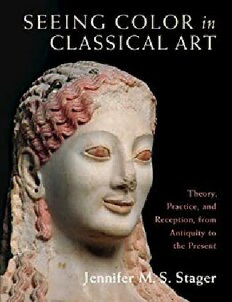
Seeing Color in Classical Art: Theory, Practice, and Reception, from Antiquity to the Present PDF
Preview Seeing Color in Classical Art: Theory, Practice, and Reception, from Antiquity to the Present
Seeing Color in C L A S S I C A L A R T Seeing Color in Classical Art offers a new critical account of color as material in ancient Mediterranean art and architecture. Traversing sites from Athens to Antioch, Stager traces color across a variety of media, including handheld panel fl paintings, painted monumental reliefs, alloyed bronzes, and mosaic oors. This book explores the materiality of color from the ground up through analysis of the pigments, dyes, stones,soils, and metals that artists crafted intopolychrome forms. Artistic practices also shaped a literary and philosophical landscape encompassing Sapphic lyric, Presocratic atomism, and Theophrastan natural history and produced a discourse on color by ancient Greek writers that reverberates in the present. Despite these abundant traces of color, ancient Mediterranean art has long been reduced to the white marble of its ruins to stageanidealized,monochromepictureofthepast.Stagerexaminestheprocess by which this reception tradition has elevated whiteness and feminized and racialized color. In response, this book illuminates the construction of the category of the classical in modernity and challenges its claims to order and exceptionalism. Ultimately, Stager harnesses ancient ideas of materiality, care, landscape, visual exchange, and artistic atomism to theorize color in the ancient Mediterranean and its afterlives. Jennifer M. S. Stager is an assistant professor in the Department of History of Art at Johns Hopkins University. Her research has been supported by the Center for Advanced Study in the Visual Arts, National Gallery of Art, Washington, DC, the Getty Research Institute, and the Harvard Center for HellenicStudies. Sheiscoauthor,withLeilaEasa,ofPublicFeminisminTimesof ’ 2022 Crisis: From Sapphos Fragments to Viral Hashtags ( ). Seeing Color in C L A S S I C A L A R T THEORY, PRACTICE, AND RECEPTION FROM ANTIQUITY TO THE PRESENT J e n n i f e r M . S . S t a g e r Johns Hopkins University ShaftesburyRoad,CambridgeCB28EA,UnitedKingdom OneLibertyPlaza,20thFloor,NewYork,NY10006,USA 477WilliamstownRoad,PortMelbourne,VIC3207,Australia 314–321,3rdFloor,Plot3,SplendorForum,JasolaDistrictCentre,NewDelhi–110025,India 103PenangRoad,#05–06/07,VisioncrestCommercial,Singapore238467 CambridgeUniversityPressispartofCambridgeUniversityPress&Assessment, adepartmentoftheUniversityofCambridge. WesharetheUniversity’smissiontocontributetosocietythroughthepursuitof education,learningandresearchatthehighestinternationallevelsofexcellence. www.cambridge.org Informationonthistitle:www.cambridge.org/9781316516454 DOI:10.1017/9781009030212 ©CambridgeUniversityPress&Assessment2022 Thispublicationisincopyright.Subjecttostatutoryexceptionandtotheprovisions ofrelevantcollectivelicensingagreements,noreproductionofanypartmaytake placewithoutthewrittenpermissionofCambridgeUniversityPress&Assessment. Firstpublished2022 PrintedintheUnitedKingdombyTJBooksLimited,PadstowCornwall AcataloguerecordforthispublicationisavailablefromtheBritishLibrary. ISBN978-1-316-51645-4Hardback CambridgeUniversityPress&Assessmenthasnoresponsibilityforthepersistence oraccuracyofURLsforexternalorthird-partyinternetwebsitesreferredtointhis publicationanddoesnotguaranteethatanycontentonsuchwebsitesis,orwillremain, accurateorappropriate. For Astrid, Felix, and Soren in all of your vibrant colors CONTENTS Acknowledgements page ix 1 Introduction CHAPTER 1 ō 31 Material Color, Language, and Khr ma CHAPTER 2 ē 90 Additive Colors, Kosm sis, and Care CHAPTER 3 ō 134 Kh ra, Relief, and Landscape CHAPTER 4 fl 182 Inlaid Eyes, Ef uences, and Opsis vii viii CONTENTS CHAPTER 5 238 Atoms, Lithoi, and Animacy 273 Epilogue 293 Select Bibliography 317 Index ACKNOWLEDGEMENTS A book about the phenomenon of color engages of necessity with brilliance fi across many elds of study, an intellectual variegation aligned with its subject. Thattheresearchandwritingofthisbooktracemuchofthearcofmyadultlife makes the prospect of giving appropriate thanks to all who have guided my thinking both daunting and exhilarating. Foremost and in the spirit of Griselda ’ fi Pollocks example to put them rst, I thank my family, who have lived with this — work Peter uprooted himself to travel with me in search of colors, for fellowships and jobs, and more recently has sustained our home in Baltimore fi lled with its assemblage of children, plants, and animals. Our three children, Soren, Felix, and Astrid have grown up with thisproject, journeying to archaeo- fi logical sites, research centers, and museums, rst carried and later alongside me by ferry, car, foot, and even onhorseback. I amgrateful todedicate this book to them. Writing about color demands structural support in both research and pro- duction. The Center for Advanced Study in the Visual Arts, where I was a Paul Mellon Predoctoral Fellow, supported research across the Mediterranean, as wellastimetocompletemydissertation.AsanNEH-GRI/MellonPostdoctoral “ ” fi Fellow at the Getty Research Institute during their Color year, I bene tted fi from expertise across elds of art, conservation, and archaeology. The Mellon/ fi Townsend Discovery fellowship both enabled my travel to the rst iteration of BunteGötterinMunich,andforgedenduringcommunityacrossdisciplinesatan early stage in my graduate career. The Deans of the Krieger School of Arts and ix
